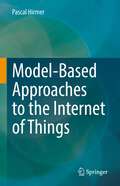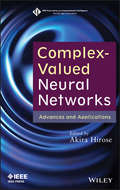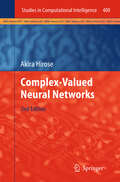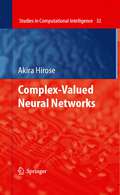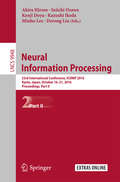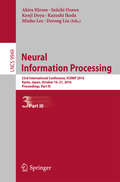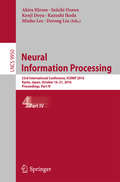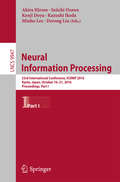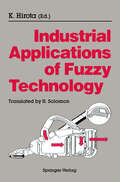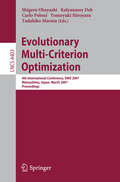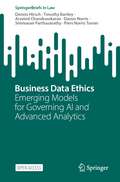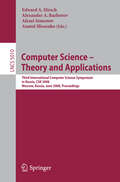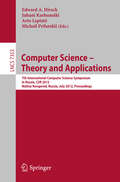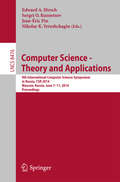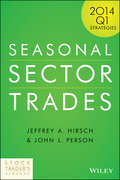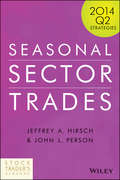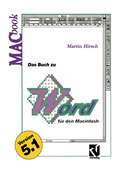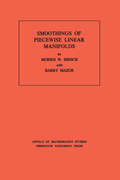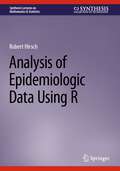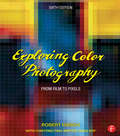- Table View
- List View
Model-Based Approaches to the Internet of Things
by Pascal HirmerThis book gives an overview of existing models that cover the whole lifecycle of an IoT application, ranging from its design, implementation, deployment, operation, and monitoring to its final termination and retirement. Models provide abstraction and can help IoT application developers into creating more robust, secure, and reliable applications. Furthermore, adaptation of applications can be eased by using these models, leading to an increased dynamic of the developed IoT applications.In the book, research of the last years in the area of model based approaches to the Internet of Things is described and these approaches are incorporated into the lifecycle of IoT applications.Finally, use cases from different domains are introduced that show how these models could be applied in real-world applications.
Complex-Valued Neural Networks: Advances and Applications (IEEE Press Series on Computational Intelligence #18)
by Akira HirosePresents the latest advances in complex-valued neural networks by demonstrating the theory in a wide range of applications Complex-valued neural networks is a rapidly developing neural network framework that utilizes complex arithmetic, exhibiting specific characteristics in its learning, self-organizing, and processing dynamics. They are highly suitable for processing complex amplitude, composed of amplitude and phase, which is one of the core concepts in physical systems to deal with electromagnetic, light, sonic/ultrasonic waves as well as quantum waves, namely, electron and superconducting waves. This fact is a critical advantage in practical applications in diverse fields of engineering, where signals are routinely analyzed and processed in time/space, frequency, and phase domains. Complex-Valued Neural Networks: Advances and Applications covers cutting-edge topics and applications surrounding this timely subject. Demonstrating advanced theories with a wide range of applications, including communication systems, image processing systems, and brain-computer interfaces, this text offers comprehensive coverage of: Conventional complex-valued neural networks Quaternionic neural networks Clifford-algebraic neural networks Presented by international experts in the field, Complex-Valued Neural Networks: Advances and Applications is ideal for advanced-level computational intelligence theorists, electromagnetic theorists, and mathematicians interested in computational intelligence, artificial intelligence, machine learning theories, and algorithms.
Complex-Valued Neural Networks: Advances and Applications (IEEE Press Series on Computational Intelligence #18)
by Akira HirosePresents the latest advances in complex-valued neural networks by demonstrating the theory in a wide range of applications Complex-valued neural networks is a rapidly developing neural network framework that utilizes complex arithmetic, exhibiting specific characteristics in its learning, self-organizing, and processing dynamics. They are highly suitable for processing complex amplitude, composed of amplitude and phase, which is one of the core concepts in physical systems to deal with electromagnetic, light, sonic/ultrasonic waves as well as quantum waves, namely, electron and superconducting waves. This fact is a critical advantage in practical applications in diverse fields of engineering, where signals are routinely analyzed and processed in time/space, frequency, and phase domains. Complex-Valued Neural Networks: Advances and Applications covers cutting-edge topics and applications surrounding this timely subject. Demonstrating advanced theories with a wide range of applications, including communication systems, image processing systems, and brain-computer interfaces, this text offers comprehensive coverage of: Conventional complex-valued neural networks Quaternionic neural networks Clifford-algebraic neural networks Presented by international experts in the field, Complex-Valued Neural Networks: Advances and Applications is ideal for advanced-level computational intelligence theorists, electromagnetic theorists, and mathematicians interested in computational intelligence, artificial intelligence, machine learning theories, and algorithms.
Complex-Valued Neural Networks (Studies in Computational Intelligence #400)
by Akira HiroseThis book is the second enlarged and revised edition of the first successful monograph on complex-valued neural networks (CVNNs) published in 2006, which lends itself to graduate and undergraduate courses in electrical engineering, informatics, control engineering, mechanics, robotics, bioengineering, and other relevant fields. In the second edition the recent trends in CVNNs research are included, resulting in e.g. almost a doubled number of references. The parametron invented in 1954 is also referred to with discussion on analogy and disparity. Also various additional arguments on the advantages of the complex-valued neural networks enhancing the difference to real-valued neural networks are given in various sections.The book is useful for those beginning their studies, for instance, in adaptive signal processing for highly functional sensing and imaging, control in unknown and changing environment, robotics inspired by human neural systems, and brain-like information processing, as well as interdisciplinary studies to realize comfortable society. It is also helpful to those who carry out research and development regarding new products and services at companies. The author wrote this book hoping in particular that it provides the readers with meaningful hints to make good use of neural networks in fully practical applications. The book emphasizes basic ideas and ways of thinking. Why do we need to consider neural networks that deal with complex numbers? What advantages do the complex-valued neural networks have? What is the origin of the advantages? In what areas do they develop principal applications? This book answers these questions by describing details and examples, which will inspire the readers with new ideas. The book is useful for those beginning their studies, for instance, in adaptive signal processing for highly functional sensing and imaging, control in unknown and changing environment, robotics inspired by human neural systems, and brain-like information processing, as well as interdisciplinary studies to realize comfortable society. It is also helpful to those who carry out research and development regarding new products and services at companies. The author wrote this book hoping in particular that it provides the readers with meaningful hints to make good use of neural networks in fully practical applications. The book emphasizes basic ideas and ways of thinking. Why do we need to consider neural networks that deal with complex numbers? What advantages do the complex-valued neural networks have? What is the origin of the advantages? In what areas do they develop principal applications? This book answers these questions by describing details and examples, which will inspire the readers with new ideas.
Complex-Valued Neural Networks (Studies in Computational Intelligence #32)
by Akira HiroseThis monograph instructs graduate- and undergraduate-level students in electrical engineering, informatics, control engineering, mechanics, robotics, bioengineering on the concepts of complex-valued neural networks. Emphasizing basic concepts and ways of thinking about neural networks, the author focuses on neural networks that deal with complex numbers; the practical advantages of complex-valued neural networks, and their origins; the development of principal applications? The book uses detailed examples to answer these questions and more.
Neural Information Processing: 23rd International Conference, ICONIP 2016, Kyoto, Japan, October 16–21, 2016, Proceedings, Part II (Lecture Notes in Computer Science #9948)
by Akira Hirose Seiichi Ozawa Kenji Doya Kazushi Ikeda Minho Lee Derong LiuThe four volume set LNCS 9947, LNCS 9948, LNCS 9949, and LNCS 9950 constitues the proceedings of the 23rd International Conference on Neural Information Processing, ICONIP 2016, held in Kyoto, Japan, in October 2016. The 296 full papers presented were carefully reviewed and selected from 431 submissions. The 4 volumes are organized in topical sections on deep and reinforcement learning; big data analysis; neural data analysis; robotics and control; bio-inspired/energy efficient information processing; whole brain architecture; neurodynamics; bioinformatics; biomedical engineering; data mining and cybersecurity workshop; machine learning; neuromorphic hardware; sensory perception; pattern recognition; social networks; brain-machine interface; computer vision; time series analysis; data-driven approach for extracting latent features; topological and graph based clustering methods; computational intelligence; data mining; deep neural networks; computational and cognitive neurosciences; theory and algorithms.
Neural Information Processing: 23rd International Conference, ICONIP 2016, Kyoto, Japan, October 16–21, 2016, Proceedings, Part III (Lecture Notes in Computer Science #9949)
by Akira Hirose Seiichi Ozawa Kenji Doya Kazushi Ikeda Minho Lee Derong LiuThe four volume set LNCS 9947, LNCS 9948, LNCS 9949, and LNCS 9950 constitues the proceedings of the 23rd International Conference on Neural Information Processing, ICONIP 2016, held in Kyoto, Japan, in October 2016. The 296 full papers presented were carefully reviewed and selected from 431 submissions. The 4 volumes are organized in topical sections on deep and reinforcement learning; big data analysis; neural data analysis; robotics and control; bio-inspired/energy efficient information processing; whole brain architecture; neurodynamics; bioinformatics; biomedical engineering; data mining and cybersecurity workshop; machine learning; neuromorphic hardware; sensory perception; pattern recognition; social networks; brain-machine interface; computer vision; time series analysis; data-driven approach for extracting latent features; topological and graph based clustering methods; computational intelligence; data mining; deep neural networks; computational and cognitive neurosciences; theory and algorithms.
Neural Information Processing: 23rd International Conference, ICONIP 2016, Kyoto, Japan, October 16–21, 2016, Proceedings, Part IV (Lecture Notes in Computer Science #9950)
by Akira Hirose Seiichi Ozawa Kenji Doya Kazushi Ikeda Minho Lee Derong LiuThe four volume set LNCS 9947, LNCS 9948, LNCS 9949, and LNCS 9950 constitues the proceedings of the 23rd International Conference on Neural Information Processing, ICONIP 2016, held in Kyoto, Japan, in October 2016. The 296 full papers presented were carefully reviewed and selected from 431 submissions. The 4 volumes are organized in topical sections on deep and reinforcement learning; big data analysis; neural data analysis; robotics and control; bio-inspired/energy efficient information processing; whole brain architecture; neurodynamics; bioinformatics; biomedical engineering; data mining and cybersecurity workshop; machine learning; neuromorphic hardware; sensory perception; pattern recognition; social networks; brain-machine interface; computer vision; time series analysis; data-driven approach for extracting latent features; topological and graph based clustering methods; computational intelligence; data mining; deep neural networks; computational and cognitive neurosciences; theory and algorithms.
Neural Information Processing: 23rd International Conference, ICONIP 2016, Kyoto, Japan, October 16–21, 2016, Proceedings, Part I (Lecture Notes in Computer Science #9947)
by Akira Hirose Seiichi Ozawa Kenji Doya Kazushi Ikeda Minho Lee Derong LiuThe four volume set LNCS 9947, LNCS 9948, LNCS 9949, and LNCS 9950 constitutes the proceedings of the 23rd International Conference on Neural Information Processing, ICONIP 2016, held in Kyoto, Japan, in October 2016. The 296 full papers presented were carefully reviewed and selected from 431 submissions. The 4 volumes are organized in topical sections on deep and reinforcement learning; big data analysis; neural data analysis; robotics and control; bio-inspired/energy efficient information processing; whole brain architecture; neurodynamics; bioinformatics; biomedical engineering; data mining and cybersecurity workshop; machine learning; neuromorphic hardware; sensory perception; pattern recognition; social networks; brain-machine interface; computer vision; time series analysis; data-driven approach for extracting latent features; topological and graph based clustering methods; computational intelligence; data mining; deep neural networks; computational and cognitive neurosciences; theory and algorithms.
Industrial Applications of Fuzzy Technology
by Kaoru HirotaThe application of fuzzy technology is widely known as a technological revolution. Shortly after it appeared, its value has rapidly become appreciated. It is absolutely indispensable for introducing the latest developments not only domestically but also internationally. This book is arranged to introduce easy to understand explanations mainly centered on concrete applications. It consists of twelve chapters in total which are all independently readable and provide different approaches on various projects. The minimum of Fuzzy Theory that is needed to understand its practical applications is given in Chapter 1. Chapters 2 to 5 discuss hardware, including chips, and software tools used in constructing system. Chapters 6 to 12 cover a series of practical applications. These in clude applications for industrial processes and plants, transportation systems, which were among the first applications, and applications for consumer products such as household electrical appliances. These elements together finally produced the worldwide "Fuzzy Boom". This book can be read by a wide variety of people, from undergraduate and graduate students in universities to practical engineers and project managers working in plants. The information contained in this book is a first step to this field of interest.
Evolutionary Multi-Criterion Optimization: 4th International Conference, EMO 2007, Matsushima, Japan, March 5-8, 2007, Proceedings (Lecture Notes in Computer Science #4403)
by Tomoyuki Hiroyasu Tadahiko Murata Shigeru Obayashi Kalyanmoy Deb Carlo PoloniThis book constitutes the refereed proceedings of the 4th International Conference on Evolutionary Multi-Criterion Optimization, EMO 2007, held in Matsushima, Japan in March 2007. The 65 revised full papers presented together with 4 invited papers are organized in topical sections on algorithm design, algorithm improvements, alternative methods, applications, engineering design, many objectives, objective handling, and performance assessments.
Digital Humanities Pedagogy: Practices, Principles and Politics (Digital Humanities Series #3)
by Brett D. HirschAcademic institutions are starting to recognize the growing public interest in digital humanities research, and there is an increasing demand from students for formal training in its methods. Despite the pressure on practitioners to develop innovative courses, scholarship in this area has tended to focus on research methods, theories and results rather than critical pedagogy and the actual practice of teaching. The essays in this collection offer a timely intervention in digital humanities scholarship, bringing together established and emerging scholars from a variety of humanities disciplines across the world. The first section offers views on the practical realities of teaching digital humanities at undergraduate and graduate levels, presenting case studies and snapshots of the authors’ experiences alongside models for future courses and reflections on pedagogical successes and failures. The next section proposes strategies for teaching foundational digital humanities methods across a variety of scholarly disciplines, and the book concludes with wider debates about the place of digital humanities in the academy, from the field’s cultural assumptions and social obligations to its political visions. Digital Humanities Pedagogy broadens the ways in which both scholars and practitioners can think about this emerging discipline, ensuring its ongoing development, vitality and long-term sustainability.
Business Data Ethics: Emerging Models for Governing AI and Advanced Analytics (SpringerBriefs in Law)
by Dennis Hirsch Timothy Bartley Aravind Chandrasekaran Davon Norris Srinivasan Parthasarathy Piers Norris TurnerThis open access book explains how leading business organizations attempt to achieve the responsible and ethical use of artificial intelligence (AI) and other advanced information technologies. These technologies can produce tremendous insights and benefits. But they can also invade privacy, perpetuate bias, and otherwise injure people and society. To use these technologies successfully, organizations need to implement them responsibly and ethically. The question is: how to do this? Data ethics management, and this book, provide some answers. The authors interviewed and surveyed data ethics managers at leading companies. They asked why these experts see data ethics as important and how they seek to achieve it. This book conveys the results of that research on a concise, accessible way. Much of the existing writing on data and AI ethics focuses either on macro-level ethical principles, or on micro-level product design and tooling. The interviews showed that companies need a third component: data ethics management. This third element consists of the management structures, processes, training and substantive benchmarks that companies use to operationalize their high-level ethical principles and to guide and hold accountable their developers. Data ethics management is the connective tissue makes ethical principles real. It is the focus of this book. This book should be of use to organizations that wish to improve their own data ethics management efforts, legislators and policymakers who hope to build on existing management practices, scholars who study beyond compliance business behavior, and members of the public who want to understand better the threats that AI poses and how to reduce them.
Computer Science - Theory and Applications: Third International Computer Science Symposium in Russia, CSR 2008, Moscow, Russia, June 7-12, 2008, Proceedings (Lecture Notes in Computer Science #5010)
by Edward A. Hirsch Alexander A. Razborov Alexei Semenov Anatol SlissenkoThis book constitutes the refereed proceedings of the Third International Computer Science Symposium in Russia, CSR 2008, held in Moscow, Russia, June 7-12, 2008. The 33 revised papers presented together with 5 invited papers and one opening lecture were carefully reviewed and selected from 103 submissions. All major areas in computer science are addressed. The theory track deals with algorithms, protocols, and data structures; complexity and cryptography; formal languages, automata and their applications to computer science; computational models and concepts; proof theory and applications of logic to computer science. The application part comprises programming and languages; computer architecture and hardware design; symbolic computing and numerical applications; application software; artificial intelligence and robotics.
Computer Science -- Theory and Applications: 7th International Computer Science Symposium in Russia, CSR 2012, Niszhny Novgorod, Russia, July 3-7, 2012, Proceedings (Lecture Notes in Computer Science #7353)
by Edward Hirsch Juhani Karhumäki Arto Lepistö Michail PrilutskiiThis book constitutes the proceedings of the 7th International Computer Science Symposium in Russia, CSR 2012, held in Nizhny Novgorod in July 2012. The 28 full papers presented in this volume were carefully reviewed and selected from 66 submissions. CSR 2012 was one of the events of the Alan Turing Year 2012, the topics dealt with cover substantial parts of theoretical computer science and its applications.
Computer Science - Theory and Applications: 9th International Computer Science Symposium in Russia, CSR 2014, Moscow, Russia, June 7-11, 2014. Proceedings (Lecture Notes in Computer Science #8476)
by Edward Hirsch Sergei O. Kuznetsov Jean-Eric Pin Nikolay VereshchaginThis book constitutes the proceedings of the 9th International Computer Science Symposium in Russia, CSR 2014, held in Moscow, Russia, in June 2014. The 27 full papers presented in this volume were carefully reviewed and selected from 76 submissions. In addition the book contains 4 invited lectures. The scope of the proposed topics is quite broad and covers a wide range of areas in theoretical computer science and its applications.
Seasonal Sector Trades: 2014 Q1 Strategies
by Jeffrey A. Hirsch John L. PersonCommodity Trader's Almanac is now Seasonal Sector Trades! Strategies identifying the best-performing seasonal trades for the first quarter of 2014 Seasonal tendencies and cycles provide a foundation for profitable trading. This edition of Seasonal Sector Trades contains trade ideas and strategies for the first quarter (Q1) of 2014. It identifies the best trades for each month based on historic tendencies and cycles. A special report is issued covering stocks, bonds, currencies, energy, metals, grains, soft commodities, and meats. Concise and to-the-point, the report describes monthly price tendencies for each market, alerting you to major trading opportunities. An accompanying strategy calendar shows you what to monitor during the beginning, middle, and end of each month. In addition to this information, daily exits and entries are provided for trades with the best historic performance. Backstopping the trade ideas are articles on the major trades of the month and in-depth analysis on the historic price patterns of the underlying market. The trading ideas and data allow you to compare current market conditions against historic tendencies and make informed trading decisions along the way. Includes in-depth analysis and data of the seasonal tendencies of all major financial and commodity markets Details trading tips and strategies to maximize profits from suggested trades Based on years of proven historical data The culmination of years of painstaking research, this quarterly guide will provide you with the historic knowledge to spot big trades unfolding in today's markets.
Seasonal Sector Trades: 2014 Q1 Strategies
by Jeffrey A. Hirsch John L. PersonCommodity Trader's Almanac is now Seasonal Sector Trades! Strategies identifying the best-performing seasonal trades for the first quarter of 2014 Seasonal tendencies and cycles provide a foundation for profitable trading. This edition of Seasonal Sector Trades contains trade ideas and strategies for the first quarter (Q1) of 2014. It identifies the best trades for each month based on historic tendencies and cycles. A special report is issued covering stocks, bonds, currencies, energy, metals, grains, soft commodities, and meats. Concise and to-the-point, the report describes monthly price tendencies for each market, alerting you to major trading opportunities. An accompanying strategy calendar shows you what to monitor during the beginning, middle, and end of each month. In addition to this information, daily exits and entries are provided for trades with the best historic performance. Backstopping the trade ideas are articles on the major trades of the month and in-depth analysis on the historic price patterns of the underlying market. The trading ideas and data allow you to compare current market conditions against historic tendencies and make informed trading decisions along the way. Includes in-depth analysis and data of the seasonal tendencies of all major financial and commodity markets Details trading tips and strategies to maximize profits from suggested trades Based on years of proven historical data The culmination of years of painstaking research, this quarterly guide will provide you with the historic knowledge to spot big trades unfolding in today's markets.
Seasonal Sector Trades: 2014 Q2 Strategies
by Jeffrey A. Hirsch John L. PersonCommodity Trader's Almanac is now Seasonal Sector Trades! A precise seasonal investment strategy, backed by research and hard data Seasonal Sector Trades: 2014 Q2 Strategies is a comprehensive strategy calendar detailing the trades to evaluate at key points in April, May, and June, based on historic tendencies and cycles. Concise and to the point, this report alerts readers to major trade opportunities by describing monthly price tendencies for each market, along with in-depth analysis of major trades and the underlying market conditions. The trading ideas are accompanied by data that allows for informed trading decisions, and precise dates are given for trades with the highest historic profitability percentages. Virtually every market displays seasonal tendencies due to weather, harvest cycles, or even human behavior. None of these patterns are 100 percent accurate, but they do provide a framework for assessing opportunity and targeting potential trades. The culmination of years of painstaking research, Seasonal Sector Trades offers expert guidance backed by hard data. Readers will gain insight and actionable advice on the best trades of the season, covering stocks, bonds, currencies, energy, metals, grains, soft commodities, and meats. This report contains crucial information traders need to take advantage of seasonal trends, including features like: Historical tendencies for all markets throughout the calendar year Trades to monitor throughout each month Precise entry and exits for trades with the best performance Trading tips and strategies to maximize profits A complete seasonal investment strategy can take years to research and compile. Markets must be monitored and analyzed, and their behavior must be correlated with outside factors. Along the way, opportunities are missed and money is lost. This report contains the results of all that work in an already-complete format. With high-level analysis and specialist insight, Seasonal Sector Trades is the industry's most authoritative guide to the seasonal tendencies of every major market.
Seasonal Sector Trades: 2014 Q2 Strategies
by Jeffrey A. Hirsch John L. PersonCommodity Trader's Almanac is now Seasonal Sector Trades! A precise seasonal investment strategy, backed by research and hard data Seasonal Sector Trades: 2014 Q2 Strategies is a comprehensive strategy calendar detailing the trades to evaluate at key points in April, May, and June, based on historic tendencies and cycles. Concise and to the point, this report alerts readers to major trade opportunities by describing monthly price tendencies for each market, along with in-depth analysis of major trades and the underlying market conditions. The trading ideas are accompanied by data that allows for informed trading decisions, and precise dates are given for trades with the highest historic profitability percentages. Virtually every market displays seasonal tendencies due to weather, harvest cycles, or even human behavior. None of these patterns are 100 percent accurate, but they do provide a framework for assessing opportunity and targeting potential trades. The culmination of years of painstaking research, Seasonal Sector Trades offers expert guidance backed by hard data. Readers will gain insight and actionable advice on the best trades of the season, covering stocks, bonds, currencies, energy, metals, grains, soft commodities, and meats. This report contains crucial information traders need to take advantage of seasonal trends, including features like: Historical tendencies for all markets throughout the calendar year Trades to monitor throughout each month Precise entry and exits for trades with the best performance Trading tips and strategies to maximize profits A complete seasonal investment strategy can take years to research and compile. Markets must be monitored and analyzed, and their behavior must be correlated with outside factors. Along the way, opportunities are missed and money is lost. This report contains the results of all that work in an already-complete format. With high-level analysis and specialist insight, Seasonal Sector Trades is the industry's most authoritative guide to the seasonal tendencies of every major market.
Smoothings of Piecewise Linear Manifolds. (AM-80), Volume 80
by Morris W. Hirsch Barry MazurThe intention of the authors is to examine the relationship between piecewise linear structure and differential structure: a relationship, they assert, that can be understood as a homotopy obstruction theory, and, hence, can be studied by using the traditional techniques of algebraic topology. Thus the book attacks the problem of existence and classification (up to isotopy) of differential structures compatible with a given combinatorial structure on a manifold. The problem is completely "solved" in the sense that it is reduced to standard problems of algebraic topology. The first part of the book is purely geometrical; it proves that every smoothing of the product of a manifold M and an interval is derived from an essentially unique smoothing of M. In the second part this result is used to translate the classification of smoothings into the problem of putting a linear structure on the tangent microbundle of M. This in turn is converted to the homotopy problem of classifying maps from M into a certain space PL/O. The set of equivalence classes of smoothings on M is given a natural abelian group structure.
Analysis of Epidemiologic Data Using R (Synthesis Lectures on Mathematics & Statistics)
by Robert HirschThis book addresses the description and analysis of occurrence data frequently encountered in epidemiological studies. With the occurrence of Covid-19, people have been exposed to the analysis and interpretation of epidemiological data. To be informed consumers of this information, people need to understand the nature and analysis of these data. Effort is made to emphasize concepts rather than mathematics. Subjects range from description of the frequencies of disease to the analysis of associations between the occurrence of disease and exposure. Those analyses begin with simple associations and work up to complex relationships that involve the control of extraneous characteristics. Analyses rely on the statistical software R, which is freeware in wide use by professional epidemiologists and other scientists.
Exploring Color Photography: From Film to Pixels
by Robert HirschRobert Hirsch’s Exploring Color Photography is the thinking photographer’s guide to color imagemaking. Now in its sixth edition, this pioneering text clearly and concisely instructs students and intermediate photographers in the fundamental aesthetic and technical building blocks needed to create thought-provoking digital and analog color photographs. Taking both a conceptual and pragmatic approach, the book avoids getting bogged down in complex, ever-changing technological matters, allowing it to stay fresh and engaging. Known as the Bible of Color Photography, its stimulating assignments encourage students to be adventurous and to take responsibility for learning and working independently. The emphasis on design and postmodern theoretical concepts stresses the thought process behind the creation of intriguing images. It’s extensive and inspiring collection of images and accompanying captions allow makers to provide insight into how photographic methodology was utilized to visualize and communicate their objectives. The text continues to deliver inspiring leadership in the field of color photography with the latest accurate information, ideas, commentary, history, a diverse collection of contemporary images, and expanded cellphone photography coverage. A "Problem Solving and Writing" chapter offers methods and exercises that help one learn to be a visual problem solver and to discuss and write succinctly about the concepts at the foundation of one’s work. Exploringcolorphotography.com, the companion website, has been revamped and updated to feature more student and teacher resources, including a new web-based timeline: As It Happened: A Chronological History of Color Photography.
Exploring Color Photography: From Film to Pixels
by Robert HirschRobert Hirsch’s Exploring Color Photography is the thinking photographer’s guide to color imagemaking. Now in its sixth edition, this pioneering text clearly and concisely instructs students and intermediate photographers in the fundamental aesthetic and technical building blocks needed to create thought-provoking digital and analog color photographs. Taking both a conceptual and pragmatic approach, the book avoids getting bogged down in complex, ever-changing technological matters, allowing it to stay fresh and engaging. Known as the Bible of Color Photography, its stimulating assignments encourage students to be adventurous and to take responsibility for learning and working independently. The emphasis on design and postmodern theoretical concepts stresses the thought process behind the creation of intriguing images. It’s extensive and inspiring collection of images and accompanying captions allow makers to provide insight into how photographic methodology was utilized to visualize and communicate their objectives. The text continues to deliver inspiring leadership in the field of color photography with the latest accurate information, ideas, commentary, history, a diverse collection of contemporary images, and expanded cellphone photography coverage. A "Problem Solving and Writing" chapter offers methods and exercises that help one learn to be a visual problem solver and to discuss and write succinctly about the concepts at the foundation of one’s work. Exploringcolorphotography.com, the companion website, has been revamped and updated to feature more student and teacher resources, including a new web-based timeline: As It Happened: A Chronological History of Color Photography.
